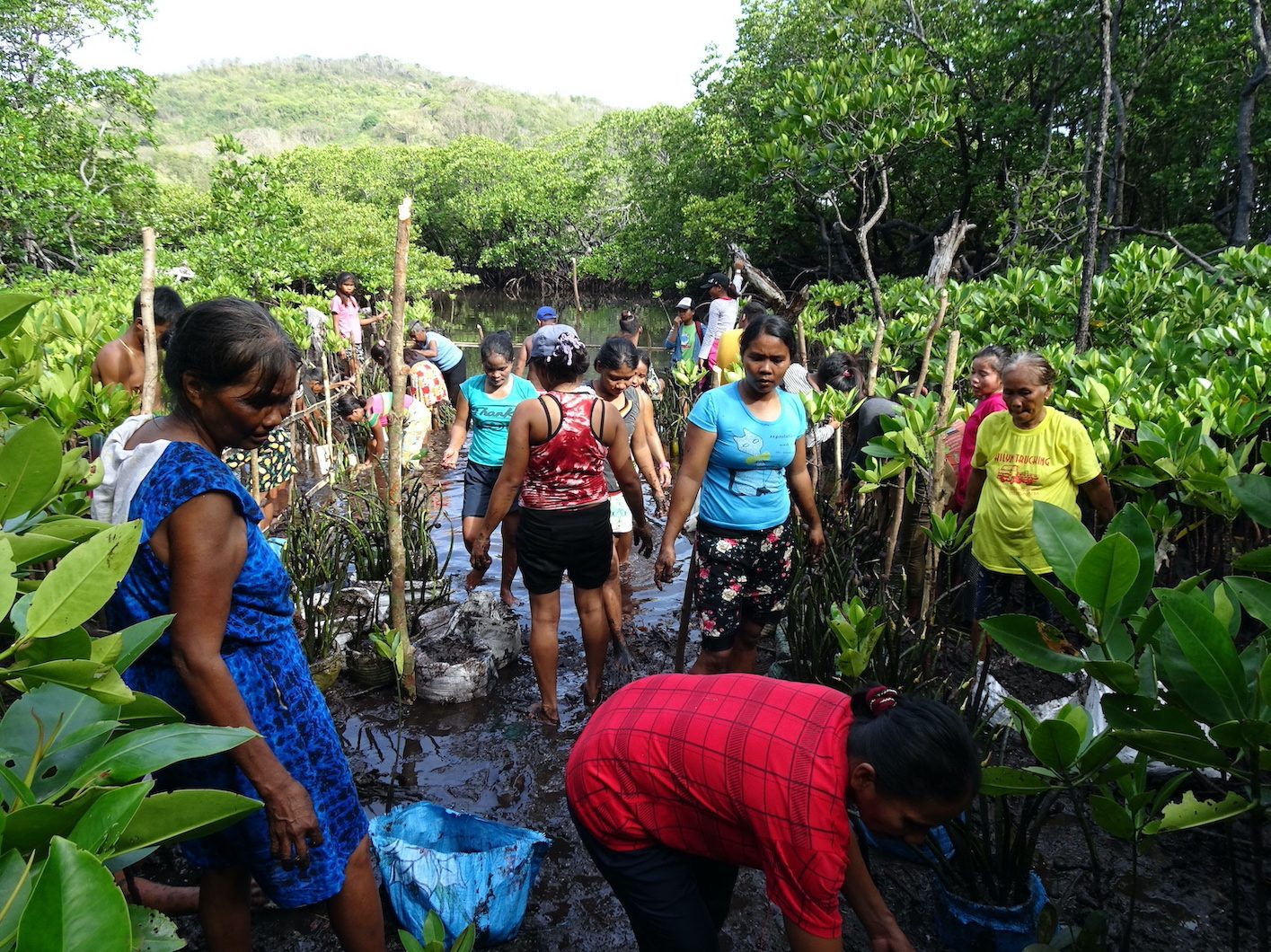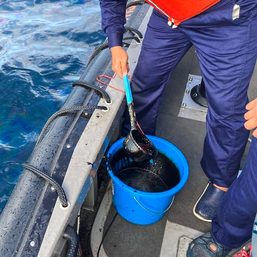SUMMARY
This is AI generated summarization, which may have errors. For context, always refer to the full article.

First of 2 parts
Conclusion: How marine ecosystems have been kept intact in the high seas
PALAWAN, Philippines – In Calibangbangan, an island barangay in Linapacan, Palawan, you will see marine turtles when you go snorkeling in the morning, according to Sophia Flores, president of women’s movement Kilos Kababaihan.
Linapacan, located in the northern part of Palawan, has a population of over 16,000 spread across 10 island barangays. Here, Flores works as a guard or enforcer of the marine protected area (MPA) between Calibangbangan and adjacent small island Takling.
MPAs help protect important habitats and representative samples of marine life in the Philippines, one of the world’s centers of marine biodiversity. They assist in restoring the productivity of the oceans and avoid their further degradation.
There are 1,922 marine protected areas in the Philippines as of January 12, according to the MPA database of the Marine Protected Area Support Network.
In the Calamianes Island Group (CIG), while there are 43 MPAs, only 34 are “legislated,” according to Ma. Christina Dalusung-Rodriguez, district manager of the Palawan Council for Sustainable Development (PCSD) in Calamianes and CAMS (Cuyo, Agutaya and Magsaysay).
The PCSD was created in 1992 for the sustainable development of Palawan. It designates which areas are terrestrial, coastal, or marine, and which ones to conserve and protect.
The council also implements Republic Act (RA) No. 9147 or the Wildlife Resources Conservation and Protection Act, and is the authority on CITES or the Convention on International Trade in Endangered Species of Wild Fauna and Flora in Palawan. It issues various permits related to wildlife regulation and enforcement.
In the town of Linapacan, Flores works with 37 Tagbanua women who help clean the coast and watch and restore the mangrove areas, including a nursery.
They also watch over seagrass beds, said Raffy Agustin, assistant field program officer of Path Foundation Philippines, Inc. (PFPI). PFPI is one of the consortium of partners of Fish Right, a flagship program of USAID in partnership with the Philippine government to advance sustainable fisheries management and marine biodiversity conservation in the Philippines.
Women like Flores – especially Tagbanua and other indigenous women – from Linapacan and other towns in the CIG (Culion, Busuanga, and Coron) have figured prominently in safeguarding MPAs, including marine species that either nest in, or migrate to, the isles.

Conserving marine turtles, other migratory species
These women are doing important work considering that there is a dire need to conserve populations of marine turtles the world over, according to a paper co-written in 2016 by Reynante Ramilo, program coordinator of conservation group Community Centred Conservation (C3) Philippines. C3 Philippines is focused on fisheries management, mangrove conservation and rehabilitation, and watershed management in the municipality of Busuanga.
Ramilo shared that during their fieldwork in communities in Busuanga, Coron, and Culion in 2016, they identified almost 36 sea turtle nesting beaches. While they were on Dimipac Island off Calauit Island in Busuanga in 2019, meanwhile, members of the community reported having seen five nesting turtles on the beach in just one night.
Rodriguez said the PCSD will conduct a survey of turtle nesting sites in Busuanga this year.
Marine turtles migrate in large numbers to a wide range of habitats and spend most of their lives in deep oceans. Young turtles can travel around 12,000 kilometers from their birth places across wide ocean basins; the same is true of adult leatherback turtles. Adult turtles, however, return to their breeding sites approximately every two years.
According to the International Union for Conservation of Nature (IUCN) – the global authority on the status and protection of the natural world – sea turtles are particularly threatened in the high seas because of their highly migratory nature, with all seven species of sea turtles currently listed as endangered under CITES.
“High seas means all seas. Sea turtles are threatened because they move long distances and are exposed to dangers along the way, such as fishers and ships,” said Alan White, marine resource management consultant for international development firm TetraTech ARD.
White helped develop an MPA monitoring system as a founding member of the Coastal Conservation and Education Foundation in the Philippines. He was also the chief of party of USAID’s Sustainable Ecosystem Advanced Project in Indonesia.
According to the paper of Ramilo’s group, Calamianes serves as foraging and nesting grounds for four of the world’s seven marine turtle species, namely:
- Green turtles (Chelonia mydas)
- Hawksbill turtles (Eretmuchelys imbricate)
- Loggerheads (Caretta caretta)
- Leatherbacks (Dermochelys coriacea)

Endangered green turtles and critically endangered hawksbills were found to nest in the Calamianes Islands, according to the paper. The most important nesting sites were located on the islands off the west of Busuanga and Culion, particularly Pamalican and Galoc, and along the north coast of Coron (Linamodio).
“The green and hawksbill sea turtles that nest in the Calamianes tend to stay mostly in the Philippines and move around the Sulu Sea and into the South China Sea waters. Leatherbacks and loggerheads migrate long distances. Leatherback sea turtles move farther, and their major nesting ground is on the east coast of Peninsular Malaysia,” said White.
However, “not all marine turtles undertake very long migrations,” he added.
“The IUCN has rated sea turtles and other threatened species by their level of threat and the extent of their living populations,” said White. “Green sea turtles have become more abundant in recent years, and are thus not critically endangered. This is because all the sea turtles are protected by law, and in the Philippines, fishers tend to leave them alone. Some communities also believe that sea turtles are good luck and will not harm them.”
Just the same, the threats in Calamianes are mostly from egg predators on beaches. White said marine turtles depend on nesting beaches for laying their eggs, which are not safe from people and predator animals that eat their eggs.
“People and animals eat the eggs, and sometimes, the beaches are affected by high tidal waters that destroy the eggs if [they are] submerged before they hatch out. Once the eggs hatch, the baby turtles are easy prey for birds and rodents such as rats, and [they] need to be protected when they go back to the sea,” said White.
“They are also affected by loss of beaches to development, and bright lights, since they will not nest if bright lights are present and [if] beach conditions are not right for laying their eggs,” he added.
While the international commercial trade of sea turtles is prohibited, they are still harvested in many countries. The IUCN proposes stronger monitoring and reporting of turtle harvesting in the high seas.
As for other migratory marine species, White added: “The whale sharks do not generally move long distances, but seem to have populations in the area where they feed and breed; so there are different populations in different parts of the Philippines. Whales are rarely seen, and do migrate thousands of kilometers from north to south, and back; while dolphins have more localized populations that do not migrate long distances.”
Tradition
Traditions and rituals are an integral part of the lives of indigenous peoples. They also have long-held beliefs and set ways that are not that easy to let go of or abandon altogether.
For instance, among the indigenous Tagbanuas of Palawan, marine turtles are sought out as delicacies, both for their meat and eggs. It is part of the tradition of indigenous Tagbanuas to serve not just wild pigs, but also marine turtles during important occasions such as weddings and christenings, said Vel Llavan, field program officer of PFPI.
Llavan added that its skin is used as an ingredient in wine, its carapace is used “for decoration,” and that locals believe the egg of the marine turtle increases sex drive.
“The sex organ of the marine turtle is scraped or drank. It is said to be effective for erectile dysfunction,” said Noel Lucio, the mandatory representative of the Tagbanua tribe in Calibangbangan. He added that most of the buyers of these are Chinese.
New York Institute of Technology criminologist Beth Adubato – who is interested in crimes against wildlife – however, said that there is no evidence that suggests turtle eggs can be aphrodisiacs. She said that turtle eggs have also been shown to have unsafe levels of heavy metals, making them potentially unsafe for human consumption.
Still, the meat of the marine turtle fetches around P1,000 (over $18), said Llavan, while the dried skin costs “millions in the market.”
According to Regem Gigante, chair of the Municipal Fisheries and Aquatic Resources Management Council (MFARMC) in Culion, Palawan, between the years 2015 and 2017, they monitored in their town buyers all the way from the municipality of Taytay, also in Palawan, who would buy marine turtles for P4,500 (over $81) apiece.
The MFARMC recommends the integration of management policies and plans on fisheries and aquatic resources into the Local Development Plan.
Linapacan Mayor Emil Neri said that dried marine turtles are openly sold at Ngongping’s Fishing Village in Hong Kong for HKD6,000 (over P42,000 or over $764) apiece. “Exotic” species are available there as well, he said. The place is known for these.
White, meanwhile, revealed that “the market for sea turtle shells is mostly for wedding ceremonies in Japan. But Japan is also stricter now in preventing importation.”
“Some Chinese boats will capture sea turtles and sell them wherever they can,” he added, clarifying later on that this is practiced much less today than in the past.
Llavan said that Section 27 of RA 9147 prohibits the poaching of these species.
“Poaching of sea turtles is less common [now] than 10 to 20 years ago,” White noted. “Poaching [incidents have] declined significantly in recent years in the Philippines. Generally, the reduction of sea turtle poaching and collection of turtle eggs is a conservation success story.”
This is not to say that foreign fishers in the South China Sea no longer poach. But at least, he said, they generally do not fish too close to Philippine shores.
In the 1970s and 1980s, fishers targeted whale sharks and manta rays. They are now protected by law and seen as a big attraction for tourists, bringing revenue to local communities and considered much more valuable as a tourist attraction rather than for food.

Role of women in fisheries conservation
At least 30% of internationally recognized MPAs – or what indigenous peoples consider sacred – are officially protected by the state through laws such as the Local Government Code of 1991 and the Philippine Fisheries Code of 1998, said Llavan.
“All the MPAs in the Calamianes Islands are either under municipal ordinance or are under National Integrated Protected Areas System (NIPAS) protection. Due to the indigenous rights law in the Philippines, most of the indigenous areas that are declared are also protected under the NIPAS law for protected areas,” White said.
He added, “Women have always been active in Philippine MPAs since [they] often have dominant roles in coastal communities.”
Take for instance the case of the Apo Island marine reserve in Negros Oriental. White noted that in its early days, it was the fishers’ wives who came to meetings and convinced their husbands about the value of the MPA and having a no-fishing area in their island. Apo Island is located in Dauin, Negros Oriental, east of central Palawan. (READ: Tagbanua women transform pandemic woes to marine protection work in Palawan)
The same is true in Culion, where women “lead in fisheries and have a role in conservation,” according to Gigante. At least 5% of them are indigenous Tagbanua or are from other indigenous groups.
Noli Llavan, the younger brother of Vel Llavan and also the project manager of social development organization Culion Foundation Inc. (CFI) for Coron and Culion, added: “The women of Culion are highly aware of conservation. They help in registering boats; in fisheries registration and licensing. They advocate and champion gender equality.”
According to Ramilo, women play a crucial role in conservation efforts by influencing members of their families and their fellow women.
Jose Mazo, park manager of the Siete Pecados Marine Park in Coron, agreed, “Matindi sila (They are amazing).” In Coron, the women initiated the Fish Right Program community watch system, where community members report illegal, unreported and unregulated (IUU) fishing.
“The women feed information to us when they spot a turtle or horseshoe crab. We verify the report. Usually, these marine species are stranded in the seagrass bed when high tide has receded. Around 95% of the women in Coron’s MPA are indigenous,” Mazo added.
According to White, women are more sensitive to the problem of managing the family income. They educate their husbands and encourage them to comply, especially if they would benefit financially from more fish or tourism due to an MPA in the area.
“The women were introduced to systematic MPA planning. The knowledge of MPA managers evolved as women successfully reforested the mangroves,” USAID Fish Right chief of party Nygiel Armada noted.
In Linapacan, the addition of women-managed areas (WMAs) in barangays Maroyogroyog, New Calaylayan, and Barangonan – totaling 957.8 hectares – increased the MPAs in the island barangay. A WMA is a tool to manage and protect products and resources used by women fishers within coastal zones managed by women fishers’ groups.
All these contributions are a testament to the strength of the women of Calamianes – the ones at the forefront of protecting marine turtles and other migratory species visiting from the high seas. (Conclusion: How marine ecosystems have been kept intact in the high seas) – Rappler.com
$1 = P55.24
Reporting for this story was supported by Internews’ Earth Journalism Network (EJN).
Add a comment
How does this make you feel?














There are no comments yet. Add your comment to start the conversation.